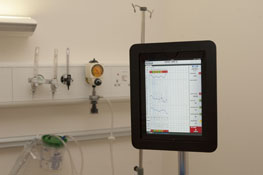Dec 13 2013
Handwritten medical observation charts could become a thing of the past in hospitals with the development of a pioneering patient monitoring system developed in Oxford hospitals.
 The new track-and-trigger tablet system integrates patient vital signs with an early warning system
The new track-and-trigger tablet system integrates patient vital signs with an early warning system
An iPad-based early-warning system developed with Engineering and Physical Sciences Research Council (EPSRC) funding is one of the projects funded by the ‘Safer Hospitals, Safer Wards’ £260 million NHS Technology Fund to improve patient safety. The £1.1 million funding will allow the team of biomedical engineers and clinicians from the University of Oxford and the Oxford University Hospitals (OUH) NHS Trust to roll out the system across all adult wards in the Trust’s acute hospitals.
The new approach uses the latest computer tablet technology both to record and to evaluate patients’ vital signs. It will help alert medical staff to patient deterioration on the wards more reliably.
You can find out more about the research in an audio slideshow below:
Digitising Healthcare | New iPad-based Early Warning System for Hospital Patient Monitoring
The Research Council UK’s Digital Economy Programme, which is led by the Engineering and Physical Sciences Research Council, funded the research underpinning this unique ‘track-and-trigger’ system; its translation onto the ward was supported by the Oxford Biomedical Research Centre (BRC), which brings together university academics with clinicians at the Oxford University Hospitals (OUH) NHS Trust.
Just as now, nurses will regularly take readings of a patient’s vital signs such as heart rate and blood pressure. But instead of writing the information on an observation chart, they will input it into an iPad or computer tablet. An Early Warning Score will then be calculated automatically and displayed instantly. The nurse will use this score to help decide whether medical intervention is needed.
Researchers in the University of Oxford’s Institute of Biomedical Engineering (IBME) and clinical staff from the OUH Trust, in particular Intensive Care Medicine specialists Drs Peter Watkinson and Tim Bonnici, have worked in close collaboration to develop the system. The EPSRC-funded Centre for Doctoral Training at the IBME is also enabling the study of the clinical impact of the new system at first hand across a variety of wards.
“The new system will help nurses, who work in busy, high-pressure environments, care for patients more efficiently and effectively,” says Professor Lionel Tarassenko, Professor of Electrical Engineering, who leads the project.
“The traditional chart-based method of recording vital-sign data is susceptible to errors in both recording and analysis of vital signs. This has been shown in multiple studies, including one funded by the Oxford BRC. Furthermore it limits the availability of the data to the bedside, making its sharing across the hospital difficult.
“The new electronic system automatically calculates the hospital’s Early Warning Score, a scoring system which we have developed from extensive statistical studies of patient data. This highlights combinations of vital-sign readings which give cause for concern. The system also enables all vital-sign data and scores to be accessed instantly by all relevant healthcare staff, wherever in the hospital they may be.”
In the future, it is planned to take advantage of next-generation scores tailored to different patient groups, for example those recovering from surgery.
At present, six vital signs are measured to calculate the Early Warning Score: heart rate, respiratory rate, blood pressure, arterial oxygen saturation (‘the sats’), temperature and level of consciousness. Details of oxygen therapy and clinical concerns can also be recorded on the iPad at the same time. The system has been designed with the future in mind so that it can easily be extended to include other data, such as blood sugar levels or neurological observations.
“The system is currently being rolled out across three wards and then, with the help of the ‘Safer Hospitals, Safer Wards’ funding, across the whole of the Oxford University Hospitals Trust next year,” says Professor Tarassenko. “We see the new system as a major step towards the ‘digital hospital’ in which all sources of patient information are interlinked and all healthcare staff are interconnected. This can only have a positive impact on patient safety.”